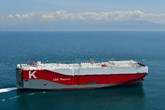DNV GL launches new tool
Published by Callum O'Reilly,
Senior Editor
LNG Industry,
DNV GL has announced that it has developed a new online PKI Methane Number Calculator to match fuel quality with an engine’s requirements. This tool can also support the development of an international standard.
The PKI Methane Number Calculator can be applied to a wide range of engine types and used across the entire supply chain by engine manufacturers, ship and truck owners, traders, as well as international policy makers on LNG.
DNV GL has developed a verified algorithm to quantify the effect of LNG quality on engine knock. This will help LNG users ensure safe and efficient engine operations. DNV GL believes that the algorithm provides an accurate reflection of the impact of variations in fuel quality on engine knock. The algorithm can also be incorporated into an engine-control system to maximise knock-free performance when supplied with a wide range of fuel.
DNV GL’s Senior Vice President, Oil & Gas, Liv Hovem, said: “As LNG is produced at different locations around the world, using an assortment of production technologies, its composition can vary considerably. Determining its fitness-for-purpose can be difficult and the consequences of mismatching fuel quality to a specific ship engine can cause potentially dangerous effects such as significant loss of performance, engine shutdown and even damage. Knowledge of the knock characteristics of LNG fuels is therefore crucial for suppliers and traders to provide reliable and efficient products and to break down the perceived barriers of adopting LNG.”
Johan Knijp, Head of Gas Quality and Energy Transition, DNV GL – Oil & Gas, said: “DNV GL’s PKI Methane Number Calculator applies a generic method to quantify the knock resistance of LNG. The methodology behind the knock characterisation calculator has been developed with an eye towards serving as the basis for a robust standard […] The user-friendly tool is based on the physical and chemical processes that govern knock and the methodology behind the tool can be applied to a wide variety of new and current marine and land-based engine types. Together with an international industrial consortium, the calculator is currently being extended to cover this full range of engines. Market analyses using the tool to characterise the range of fuel qualities can be used by the entire supply chain, by engine manufacturers, ship and truck owners, by traders and by international policy makers on LNG.”
Users of the tool enter LNG composition information (e.g. nitrogen, methane, ethane, propane and n-butane). The tool then calculates a PKI methane number, which can be matched with the engine specification.
DNV GL has also launched a joint industry project (JIP) to develop tools to support customers in investment decisions on the design of small scale LNG distribution infrastructure, and has undertaken a study on the LNG market in the EU as part of its efforts to drive the development of an EU-wide network of LNG refuelling points.
Liv Hovem added: “Step by step DNV GL is facilitating the removal of barriers hindering the safe and efficient adoption of LNG as fuel and the creation of an open and free LNG marketplace. Our cross-industry collaborations in this arena have already seen the development of a number of recommended practices relating to gas quality and bunkering. Our collaborative efforts will go a long way to increase knowledge and remove any remaining concerns about the adoption and application of LNG as a viable fuel for the future.”
Read the article online at: https://www.lngindustry.com/liquid-natural-gas/15112016/dnv-gl-launches-new-tool/
You might also like
‘K’ Line receives LNG-fuelled car carrier
An LNG-fuelled car carrier with a capacity of 6900 vehicles has been delivered to Kawasaki Kisen Kaisha, Ltd.

